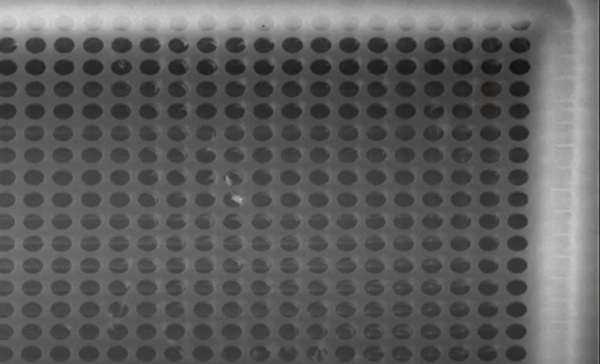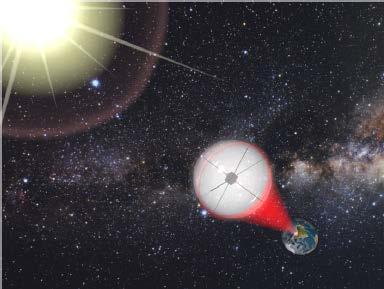Breakthrough Starshot’s concept for a flyby of Alpha Centauri would reach its destination in a single human generation. We’ve discussed sail materials in the last couple of posts, but let’s step back to the overview. Using a powerful ground-based laser, we illuminate a sail on the forward side of which are embedded instruments for communications, imaging and whatever we choose to carry. We need a sail that is roughly 4 meters by 4 meters, and one that weighs no more than a single gram.
As Richard Norte pointed out to the Interstellar Research Group’s Montreal symposium (video here), a US penny weighs 2.5 grams, which gives an idea what we are up against. We need a payload at gram-scale and a sail that is itself no more than a gram. Obviously our sail must be of nanoscale thickness, and able to take a beating, for we’re going to light it up for 10 minutes with that laser beam to drive it to 20 percent of lightspeed. We’re engineering, then, in the realm of nanotechnology, but working on combining our nanoscale components into large objects that can be fabricated at the macro-scale.

This is an uncharted frontier in the realm of precision and microsystems engineering, and it’s one that Norte and his team at Delft University of Technology are pushing into one experiment at a time, with recent funding from the EU and Limitless Space Institute. Things get fascinating quickly at this scale. To make a membrane into a mirror, you puncture your material with nanoscale holes, producing reflectivity at specific wavelengths. The Delft work is with silicon nitride, and in the current thinking of the Starshot team, this material formed as a metagrating is layered between the instruments on the lightsail and the sail body, becoming the means for keeping the sail on the beam and providing attitude control while protecting the instruments.
Image: Delft University of Technology’s Norte, whose lab focuses on novel techniques for designing, fabricating and measuring nanotechnologies needed for quantum optics and mechanics. Credit: Delft University of Technology.
At Delft, as Norte made clear, we’re a long way from achieving the kind of macrostructures that Starshot is looking at, but remember that Starshot is conceived as a multi-decade research effort that will rely on advances along the way. The Delft team is showing us how to make the thinnest conceivable mirror, using machine learning optimization techniques to optimize nanotechnology. The material of choice turns out to be silicon nitride, as we saw in our previous Starshot discussion. Says Norte:
”Of all the material people have used for making photonic crystals, silicon nitride winds up being one of the best. We can make it big, we can make it reflective, we can make it without wrinkles, and it actually has parts per million absorption. This extremely low absorption means we won’t blow this thing up when we shine a laser on it.”

Image: Scanning electron microscope image of a silicon nitride membrane. Credit: Richard Norte/Delft University of Technology. 9:47
The question is how to move to larger mirrors, given that the state of the art when Starshot was announced was at the 350-micron to a side scale. It would be helpful if we could simply ‘stitch’ smaller units together to craft a larger sail, but Norte likens that idea to trying to stitch two soap bubbles together – the structure is so amorphous, filled with the holes of the lattice – that we have to rely on manufacturing techniques that can produce larger wafers rather than combinations of smaller ones.
Scaling up is no small challenge. Norte told the audience at Montreal that his team can now make photonic crystals in the range of 450 mm to the side. The crucial term here is ‘aspect ratio,’ which relates the thickness of a metamaterial to its diameter or width. Interacting with light on the nanoscale means designing around the aspect ratio of these structures to achieve specific nanophotonic effects. Tuning the size and spacing of the holes in the lattice governs the wavelength at which the sail will reflect light.
No less important is the coupling of the laser beam with the sail, because while we are planning to accelerate these sails to speeds that are, by current standards, fantastic, we can only do so by optimizing how they interact with the beam. ‘Alignment resilience’ refers to the reaction of the sail as it is hit by the beam. New ways to arrange the nanoscale holes in the material weigh reflectivity against cost and efficiency, and Norte pointed out that a sail will need to be reflective over a wide range of light, given that it will experience large Doppler shifts in its abrupt change in velocity.
Getting this right will involve considering misalignments between the laser and the sail that can be self-adjusting depending on the design of the mirror lattice, and perhaps faster to accelerate. We seem at the moment to be decades away from being able to make meter-scale photonic crystal lightsails, a daunting thought, but Norte has an exhilarating thought about what we can do today with a sail of the 450 mm size now possible. An Alpha Centauri mission reaches target in centuries, perhaps as few as 200 years. This is assuming a one-gram payload and 70 percent reflectivity.
A wafer size fabrication of 100 mm can be used to build a sail that reaches Voyager 1 distance in 162 days, by Norte’s calculation. Even using the tiny 4.5 cm wafer Delft has already made, we could make that journey in about a year. Using the same 4.5 cm demonstrator alone, we reach Mars with a 1-gram payload in 32 hours, Saturn in 22 days, Uranus in 46 days and Neptune in 74 days. Contrast that with the speed of our fastest flyby probes. Voyager 2 took 12 years, for instance, to reach Neptune.

“It’s a compelling thought,” says Norte. “We can. send microchips to Mars the way we send international mail, just shotgunning them out there in 32 hours. Or we can get them to Titan’s oceans in less than a month. This is possible in nanotechnology today.”
Experimental work at Delft involves developing a sail that can be fabricated in a plasma etcher that allows the team to remove the silicon underneath, suspend the structure, and move it (without breaking vacuum) for lift by a laser. The dynamics of the sail under the beam can be explored, as can the question of beam-riding. Out of all this, Norte said, should come new levels of optical levitation, novel structural engineering, a new generation of sensors and detectors. In other words, new material science ahead.



I wonder if we could use multiple panes of fibre optic quality glass or silicon discs as relays. We have a stack of these panes with the final spacecraft at the front. The laser light is shone at the stack. Some light will be reflected back but moves it forwards a bit, the laser light that gets through hits the next disc and so on. In effect the stack explodes outwards with the slowest disc at the back and the spacecraft the fastest in front. The technique will allow the recycling of light between the panes which reduces the capital cost of the laser system. Let’s face it the cost of the sail will pale in comparison to the infrastructure cost which will be billions ! All the other discs which will in effect be lens and reflectors could have electronics built onto them so they to can act as slower spacecraft which can move about the system or even act as relays for signals back to earth. I must admit control of the stack would be a challenge.
Long time reader, first time poster :)
Are the test sails 4.5cm, or 450mm? I ask because 450mm is 45cm, as almost every Canadian would know :)
Glad to have you commenting, Tushar. The answer is that the test sails are 4.5 cm. The 450 mm sails (or, as you note, 45 cm) represent what Norte believes to be the largest sail we could build with today’s manufacturing techniques. But the lab sample he was talking about in his talk is 4.5 cm.
Physics seems to result in conceptually similar designs that reoccur. This idea of reducing mass by punching holes in a SiN film that still reflects light as a sail is similar to Forward’s Starwisp sail which was to be propelled by microwaves and was constructed of wires 3 mm apart. manufacture was to be space-based, printing the wires on a plastic substrate that then broke down under UV radiation leaving the wire mesh sail.
Landis did a follow-up analysis of Starwisp but concluded that it would absorb the microwave energy rather than reflect it. He suggested other sail materials, such as graphene As we saw in the previous post, Matloff considers aerographite as a “mesh” to absorb laser light.
As so we arrive at a material based on the same concept but at the far smaller scale of light wavelengths. Norte suggests that a more meshlike approach could be used, although the scale-up seems limited to hal-meter diameter sails.
I also note that Landis suggested a Starwisp mission to the planets in our system, reaching the Kuiper belt in very respectably short mission times. Norte makes the same suggestion for the much smaller “mesh” light sail. Lubin had made similar suggestions but with increased payload masses and far lower velocities on his roadmap to using DE-STAR-sized laser arrays for propulsion.
The difficulties in scaling up the sail size using the lithographic technique described by Norte seem to suggest a likely size limit to the concept, at least in the near term. The cost is also unacceptably high unless the newer mesh ideas can surmount both of these difficulties. The aerographite sail material seems to avoid these problems, but with the proviso, we don’t yet know if the thin 1-micron sail is as absorptive as hoped. Maybe the graphene material will still prove the better sail material, although again, how to scale-up its size from the graphene fragments manufactured today is still an issue.
What does seem the likely trajectory for fast, beamed sails is to push for payload miniaturization, rather than trying to scale up the sail size. This may limit what type of data can be acquired even using swarms of this micro probes, but they should offer at least some types of data. If insect eyes can resolve scenes, then there should be no reason to suppose that tiny lenses with microelectronic circuits and transmission capabilities cannot at least transmit images. We could have avoided much of the “Is ‘Oumuamua an alien space probe of not” argument is a fractional light-speed beamed sail swarm was fired at the object sending flyby images from those that passed close by the object.
New nanotube
https://www.eurekalert.org/news-releases/1004088
Boron can be harvested end of trip for zip propellants for landing
Foil
https://www.nextbigfuture.com/2023/10/three-new-technologies-to-make-superconductor-tapes.html
How much laser power do we need to drive a 1 gm payload with a 4.5 cm array to Mars in 32 hours? What about considering a bigger payload and the same sail size to get to inner planets so that we arrive with a more capable package until we catch up with microminiaturizing everything? For longer distances (beyond the solar system) are we still considering a laser railway ie. lasers positioned along the route so that one giant system is not required on Earth or the Moon? If we could put a laser in position in the outer solar system with a fairly long active “lifespan” could we drive sails outwards for decades possibly?
Seymour Cray used to talk about the concept of technological stride length, i.e. the amount of technological improvement to a design required to make it worth the time and money to develop the next generation of whatever. How big a stride is being considered now for laser driven sails? Funding agencies probably love to see huge improvements for very little money but that seems very unlikely. I think the idea of the photonic railway was the idea of Young Bae by the way. I would love to see a series of proposed laser driven sails with varying payload sizes. Just a thought. I love the concepts within your work Dr. Norte.
Crafting that sail is a prodigious task even without the porcine feeding trough that obtains with government-funded projects in the US. To integrate it with the rest of the ship and the laser source is yet another herculean task.
Invocation of Lady Luck/Fortuna may not be out of place.
Another method is woodpiling, this one reaches almost 100% at about 1.5 micron but i don’t know the absorption coefficent though.
https://www.nature.com/articles/srep21818
There some promising materials and techniques, so one day we will get it right.
https://www.nature.com/articles/s41467-022-30335-2
Interesting is the power the diamond design can withstand in continuous mode, about 17 GW per square meter. I think the design could be tweaked for better performance as well over time.
I wonder if the Moon is the right place to craft these.
Lower gravity…but still a firm foundation for equipment.
No atmosphere…electrostatics that can perhaps levitate whole sail segments without having to fold them up to fit inside rocket shrouds.
The analogy of stitching two soap bubbles together seems brilliantly inapt. After all, we see soap bubbles join together every day! Is there truly no way for an engineered SiN to zip itself together at seams, or even to assemble itself completely from microscopic subunits under the right conditions in vacuum?
Getting into space or moon allows us to more easily recycle laser light bringing down the laser infrastructure orders of magnitudes. It will allow us to kick stuff off the moon much more easily.
I’m wondering if lithography might be used to create the film instead. The chip industry went with ultra-short UV lithography to reach the very fine scale current chips. I appreciate that the lithography wavelength must be smaller than the laser wavelength, but UV would seem to fit that requirement if it can be employed for SiN films.